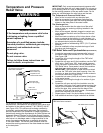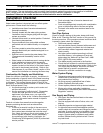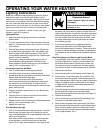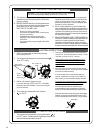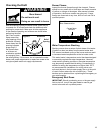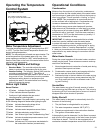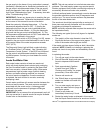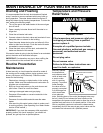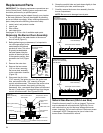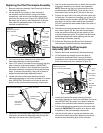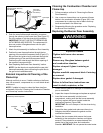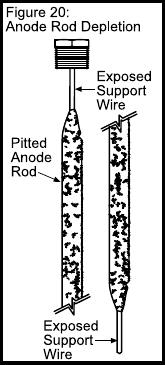
22
NOTE: This rod may reduce but not eliminate water odor
problems. The water supply system may require special
filtration equipment from a water conditioning company to
successfully eliminate all water odor problems.
Artificially softened water is exceedingly corrosive because
the process substitutes sodium ions for magnesium and
calcium ions. The use of a water softener may decrease
the life of the water heater tank.
The anode rod should be inspected after a maximum of
three years and annually thereafter until the condition of
the anode rod dictates its replacement.
NOTE: artificially softened water requires the anode rod to
be inspected annually.
The following are typical (but not all) signs of a depleted
anode rod:
• The majority of the rods diameter is less than 3/8”.
• Significant sections of the support wire (approx. 1/3 or
more of the anode rod’s length) are visible.
If the anode rod show signs of either or both it should be
replaced. NOTE: Whether re-installing or replacing the
anode rod, check for any leaks and immediately correct if
found.
In replacing the anode:
1. Turn off gas supply to the water heater.
2. Shut off the water supply and open a nearby hot water
faucet to depressurize the water
tank.
3. Drain approximately 5 gallons
of water from tank. (Refer to
“Draining and Flushing” for proper
procedures). Close drain valve.
4. Remove old anode rod.
5. Use Teflon® tape or approved pipe
sealant on threads and install new
anode rod.
6. Turn on water supply and open a
nearby hot water faucet to purge air
from water system.
7. Check for any leaks and
immediately correct any if found.
8. Restart the water heater as directed in this manual.
See the Repair Parts Illustration for anode rod location.
TEFLON
®
is a registered trademark of E.I. Du Pont De Nemours and Company.
the gas supply to the burner if poor combustion is sensed
(caused by a blocked vent or insufficient combustion air). If
the gas control valve/thermostat shuts off the gas supply,
check the diagnostic flash code and refer to the “Status
Light Code Troubleshooting Chart.” If necessary, also refer
to the “Troubleshooting Chart.”
IMPORTANT: Correct any issues prior to resetting the gas
control valve/thermostat. Reference the telephone number
on the cover of this manual for service information.
Reset the system by following these steps: 1.) Turn the
temperature adjustment knob to OFF. 2.) Unplug the
thermopile plug from the gas control valve/thermostat.
3.) Wait for about three minutes. 4.) Plug the thermopile
plug back into the gas control valve/thermostat. 5.) Turn
the temperature adjustment knob to PILOT and restart the
water heater as directed in this manual.
A temperature limit switch or ECO (Energy Cut Off) sensor
located in the gas control valve\thermostat is used to shut
off the water heater if the water temperature exceeds
189°F (87°C).
The Diagnostic Status Light will flash a code indicating
an “Overheat Failure” (4 Flashes). See “Operating the
Temperature Control System.” If the ECO has functioned
the gas control valve/thermostat should be replaced by
a qualified person. Contact your local dealer for service
information.
Anode Rod/Water Odor
Each water heater contains at least one anode rod,
which will slowly deplete (due to electrolysis) prolonging
the life of the water heater by protecting the glass-lined
tank from corrosion. Adverse water quality, hotter water
temperatures, high hot water usage, hydronic heating
devices, and water softening methods can increase
the rate of anode rod depletion. Once the anode rod
is depleted, the tank will start to corrode, eventually
developing a leak.
Certain water conditions will cause a reaction between the
anode rod and the water. The most common complaint
associated with the anode rod is a “rotten egg smell”
produced from the presence of hydrogen sulfide gas
dissolved in the water.
IMPORTANT: Do not remove this rod permanently as it will
void any warranties. A special anode rod may be available
if water odor or discoloration occurs.



